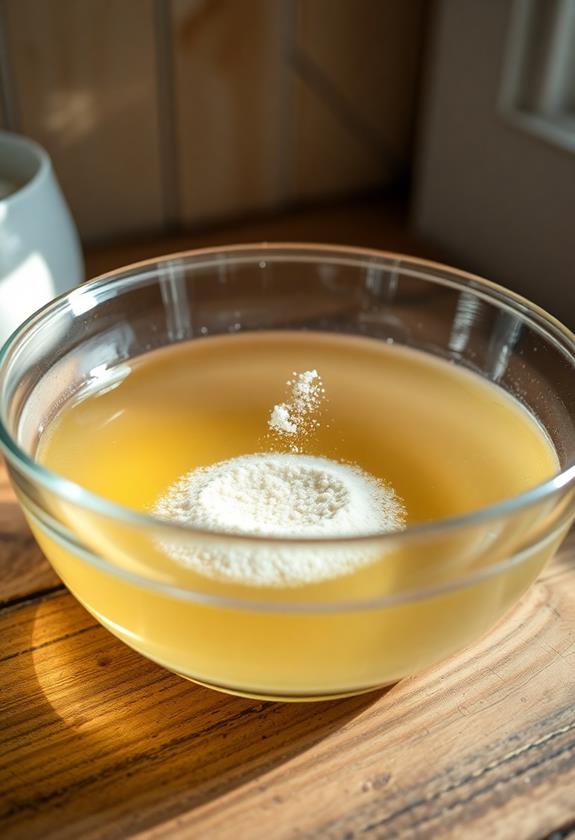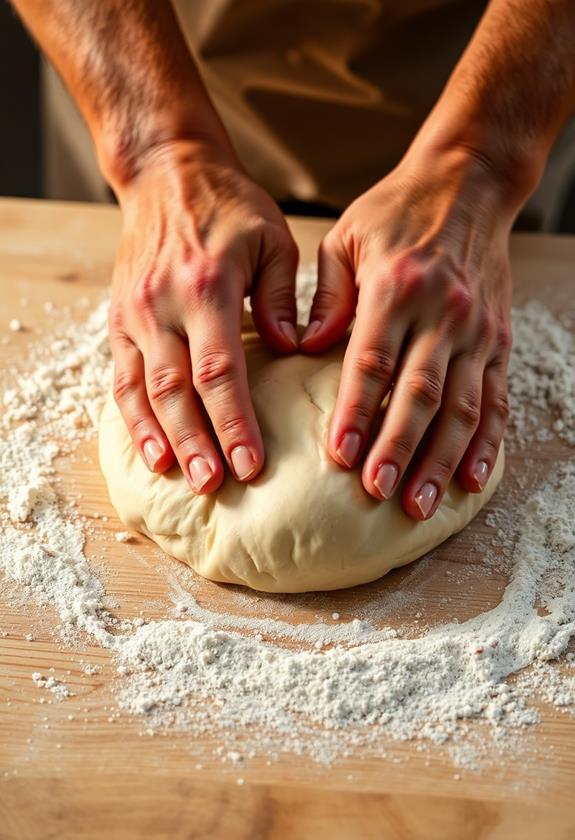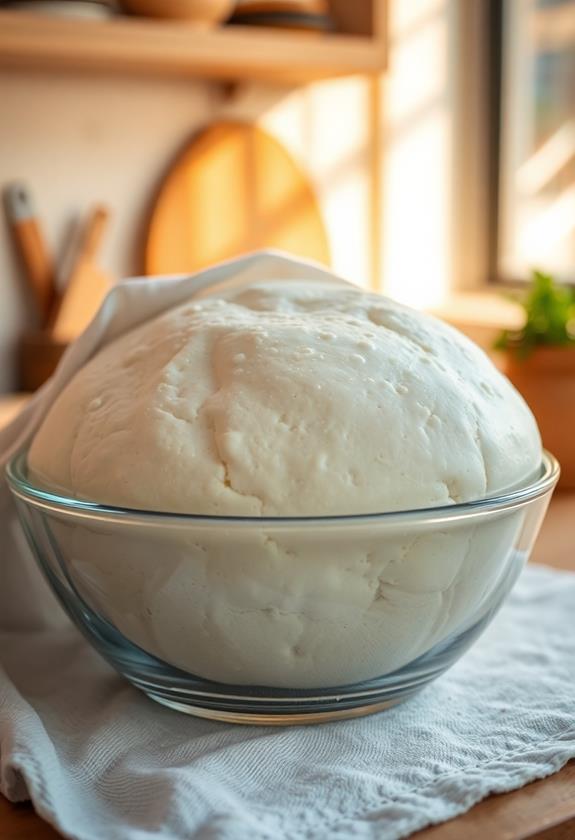Basic Pizza Dough Recipe

Crafting the perfect pizza dough starts with understanding the balance between ingredients and technique. You might think it's simply mixing flour, water, and yeast, but there's more nuance to it. By considering the texture and rise of the dough, you can elevate your homemade pizza to a level that rivals your local pizzeria. Have you ever wondered how the right kneading method or rise time can influence the final result? As you explore this basic recipe, you'll uncover tips that can transform a simple dough into a culinary masterpiece. Let's plunge into the fundamentals that make all the difference.
Recipe
Making your own pizza dough at home is both fun and satisfying, allowing you to craft pizzas with a personal touch. The process involves a few simple ingredients and straightforward steps, resulting in a dough that's flavorful and has the perfect texture.
Whether you're a novice or an experienced cook, mastering pizza dough is a rewarding skill that enhances your homemade pizza experience. All it takes is a bit of time for the dough to rise and the right baking surface to accomplish a delicious crust.
The following recipe will guide you through making pizza dough from scratch. You'll start by activating the yeast before combining it with the other ingredients to form a smooth and elastic dough. After allowing the dough to rise, you'll divide and shape it, then add your favorite toppings before baking. With practice, you'll find this process becomes an enjoyable kitchen routine.
Ingredients:
- 2 1/4 teaspoons active dry yeast
- 1 1/2 cups warm water
- 3 1/2 to 4 cups all-purpose flour
- 2 tablespoons olive oil
- 2 teaspoons salt
- 1 teaspoon sugar
Begin by dissolving the yeast and sugar in warm water, letting it sit for 5 minutes until frothy. In a mixing bowl, combine 3 1/2 cups of flour and salt. Form a well in the center and pour in the yeast mixture and olive oil. Stir until the dough begins to form, then knead on a floured surface for about 6-8 minutes, adding more flour if necessary, until smooth and elastic.
Place the dough in a lightly oiled bowl, cover, and let it rise in a warm spot for 1 to 1 1/2 hours until doubled in size. Punch down the risen dough, divide it in half, and shape each piece into your desired thickness. Top with your preferred ingredients and bake at 475°F for 12-15 minutes.
For the best results, verify your water is warm but not hot, as high temperatures can kill the yeast. Kneading is critical for dough elasticity, so don't rush this step. If you're short on time, consider letting the dough rise overnight in the refrigerator; this slow fermentation process can enhance the flavor.
Cooking Steps
Let's get started on making your pizza dough! First, you'll combine the yeast with a bit of sugar in warm water and wait until it gets all frothy, like a cappuccino on a lazy Sunday morning.
Then, mix your flour and salt in a bowl, add the yeast mixture and olive oil, and knead the dough until it's as smooth as a jazz playlist, letting it rise until it doubles in size and is ready to rock 'n' roll.
Step 1. Combine Yeast With Sugar

Kick off your pizza dough journey by dissolving the yeast and sugar in warm water. This simple step is essential, like a warm-up for your dough!
Grab your measuring spoon, and add 2 1/4 teaspoons of active dry yeast and 1 teaspoon of sugar into 1 1/2 cups of water, making sure it's just warm, not scalding—about as cozy as a bath.
Stir gently, and let it sit for around 5 minutes. You're looking for a frothy, bubbly party on the surface, a sign that your yeast is alive and ready to rock.
If nothing happens, it might be time for new yeast. This little chemistry experiment guarantees your dough rises perfectly, setting you up for pizza glory.
Step 2. Mix Flour and Salt

Grab your large mixing bowl and combine 3 1/2 cups of all-purpose flour with 2 teaspoons of salt. Give it a good stir, ensuring the salt is evenly distributed throughout the flour.
You might think this step's a bit boring, but it's essential! The salt adds flavor and strengthens the dough structure, which is key for that chewy, delicious crust you're aiming for.
Use a whisk or fork to mix, and don't worry if a little escapes—it happens to the best of us. Just sweep it back in with your hand.
This is your base, the unsung hero of your pizza. And remember, even if your day's been doughy, your pizza shouldn't be! Let's keep it fun and floury!
Step 3. Add Yeast Mixture, Olive Oil

With your flour and salt well combined, it's time to bring in the yeast mixture and olive oil to bring your dough to life.
Pour the frothy yeast mixture right into the well you've created in the dry ingredients. It's like you're casting a magical spell—watch your dough transform!
Now, drizzle in the olive oil, imagining a gentle Italian breeze carrying you to pizza perfection.
Use a sturdy spoon or your hands to mix everything together until it starts resembling a shaggy dough. Don't worry if it looks a bit messy; it's all part of the fun!
Keep stirring until there's no dry flour left. At this point, your dough's ready for some hands-on attention, but let's save that for later.
Step 4. Knead Dough Until Smooth

Once your dough starts coming together, it's time to knead it until it's smooth and elastic.
Plop it onto a floured surface, and get ready for a little upper-body workout. Using the heels of your hands, push the dough away, fold it over, and give it a quarter turn.
Repeat this process for about 6-8 minutes. It might feel like a long arm wrestle with a stubborn opponent, but trust me, it's worth it.
If the dough sticks to your hands, sprinkle a bit more flour. You'll know you're done when the dough feels slightly tacky but not sticky, and it bounces back when poked.
Congratulations! You've just turned a lumpy mess into a silky masterpiece. Enjoy this therapeutic dough dance!
Step 5. Let Dough Rise Until Doubled

After you've kneaded your dough to perfection, it's dough-rise time.
Grab a lightly oiled bowl and place your dough ball inside, gently rolling it around so it's coated with oil. Cover the bowl with a damp towel or plastic wrap.
Now, find a cozy, warm spot in your kitchen—perhaps near a sunny window or on top of the fridge—and let the dough hang out there.
You're aiming for it to double in size, which usually takes about 1 to 1 1/2 hours. Don't worry, it's not watching paint dry!
This step is essential for developing that airy, chewy texture we all love.
Once doubled, your dough's ready for the next step, so get excited—pizza perfection awaits!
Final Thoughts
Creating your own pizza dough is an enjoyable culinary adventure that yields delicious results. Imagine the smell of fresh dough baking in your kitchen; it's a delight!
Making pizza dough from scratch gives you control over flavor and texture, ensuring each bite is perfect. Plus, it's a fun way to impress friends or family at dinner.
Don't worry if your first attempt isn't flawless; practice makes perfect. Try experimenting with different toppings and seasonings for endless pizza possibilities.
Remember, cooking should be fun, not stressful, so embrace the process and enjoy the experience. And hey, if you accidentally drop some flour on the floor, consider it a part of the creative process—just like artists with paint splatters.
Enjoy your homemade pizza!
Frequently Asked Questions
Can I Use Whole Wheat Flour Instead of All-Purpose Flour?
You can definitely use whole wheat flour instead of all-purpose flour. It adds a nutty flavor and extra nutrients. Just remember to adjust the water content slightly, as whole wheat flour absorbs more moisture. Enjoy your healthier pizza crust!
How Do I Store Leftover Pizza Dough?
Store leftover pizza dough by wrapping it tightly in plastic wrap or placing it in an airtight container. Refrigerate for up to three days or freeze for up to three months. Thaw frozen dough overnight in the fridge before using.
Can This Dough Be Used for Calzones or Breadsticks?
You can definitely use this dough for calzones or breadsticks. Just shape the dough accordingly. For calzones, fill and fold them over; for breadsticks, roll and cut them into strips before baking. Enjoy your creations!
What Can I Do if My Dough Isn't Rising?
If your dough isn't rising, check the yeast's expiration date and guarantee your water isn't too hot. Let it rise in a warmer spot or try adding a pinch of sugar to activate the yeast better.
Is It Possible to Freeze the Dough for Later Use?
Yes, you can freeze pizza dough for later use. After it rises, divide it, wrap each portion tightly in plastic wrap, and place in a freezer bag. Thaw in the refrigerator overnight before using.
Conclusion
You've made it to the end, and now you've got a perfect pizza dough to show for it! Remember, patience is key—let that dough rise till it's doubled, like a magic trick in your kitchen. When it's ready, stretch it out, top it with your favorite ingredients, and bake to golden perfection. Enjoy the process, and don't worry if it's not perfect; even a quirky shape adds character. Just have fun, and savor every delicious bite!






